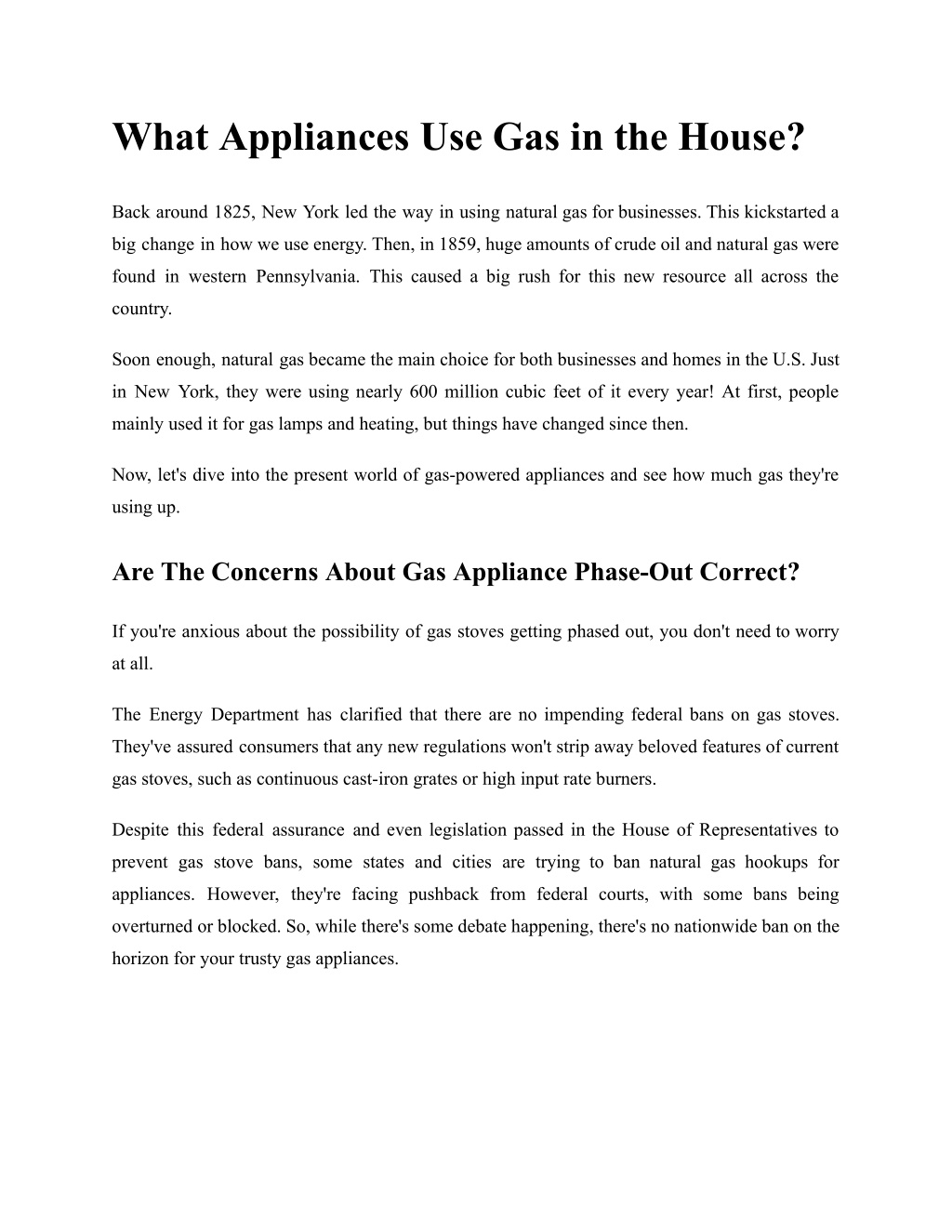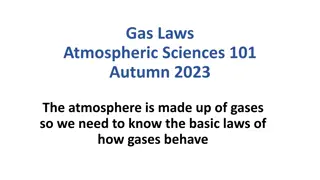
What Appliances Use Gas in the House
To avoid a safety hazard, itu2019s best to have appliancesnprofessionally installed. If you need new gas lines, hire an expert for gas line installation too.nFinally, ensure that you have your gas appliance services on hand whenever theyu2019re not workingnas you require them to be.
Download Presentation
Please find below an Image/Link to download the presentation.
The content on the website is provided AS IS for your information and personal use only. It may not be sold, licensed, or shared on other websites without obtaining consent from the author. Download presentation by click this link. If you encounter any issues during the download, it is possible that the publisher has removed the file from their server.
Presentation Transcript
What Appliances Use Gas in the House? Back around 1825, New York led the way in using natural gas for businesses. This kickstarted a big change in how we use energy. Then, in 1859, huge amounts of crude oil and natural gas were found in western Pennsylvania. This caused a big rush for this new resource all across the country. Soon enough, natural gas became the main choice for both businesses and homes in the U.S. Just in New York, they were using nearly 600 million cubic feet of it every year! At first, people mainly used it for gas lamps and heating, but things have changed since then. Now, let's dive into the present world of gas-powered appliances and see how much gas they're using up. Are The Concerns About Gas Appliance Phase-Out Correct? If you're anxious about the possibility of gas stoves getting phased out, you don't need to worry at all. The Energy Department has clarified that there are no impending federal bans on gas stoves. They've assured consumers that any new regulations won't strip away beloved features of current gas stoves, such as continuous cast-iron grates or high input rate burners. Despite this federal assurance and even legislation passed in the House of Representatives to prevent gas stove bans, some states and cities are trying to ban natural gas hookups for appliances. However, they're facing pushback from federal courts, with some bans being overturned or blocked. So, while there's some debate happening, there's no nationwide ban on the horizon for your trusty gas appliances.
Can Gas Appliances Work During Power Outages? Many people think gas appliances are a lifesaver during blackouts, but it's not that simple. Let's look at each appliance to see how they compare: Gas Furnaces: Unfortunately, they don't work during power outages. Gas Water Heaters: Usually, they need electricity to function. Gas water heaters use natural gas to heat the water in your tank. A small flame called a pilot light ignites the gas in the middle of your water heater. However, the thermostat and water level sensors usually need electricity to work. Gas Stovetops: Some models can work during a blackout, but it depends on the specific model. When starting a gas stovetop, the click you hear when turning it on is the pilot light, which requires an electric mechanism to create a spark. However, once ignited, the burner's flames can continue to cook food. Gas Ovens: Most won't work without electricity, as they need it to ignite the pilot light. This pilot is started with electric mechanisms to create the spark, making them reliant on electricity. Gas Fireplaces: Many can still provide warmth during power outages, depending on the model. Gas fireplaces work exactly like gas stoves: like a pilot ignition starts a flame. It depends on the model, but you can use your fireplace for heat when the power is out.
So, while gas appliances offer some benefits, relying on them entirely during power outages might leave you in the cold. Keep up with our blog: What to Know About the Risks of Gas Stoves and Appliances? How Many Appliances Can a 3/4 Gas Line Supply and Can You Run Two Appliances Off One Gas Line? If you are overloading your gas lines with too many appliances, it is not very safe or efficient. As it can cause pressure issues and can lead to gas leaks or appliances malfunctioning. Some houses only have gas lines that are 3/4 inch (") in diameter which is the standard size that supports heavy appliances. But a few other houses have a combination of 1-inch, 1/2-inch, and 3/4-inch gas lines. Deciding On How Many Appliances a Gas Line Can Handle? To check how many appliances your 3/4" gas line will support, you can take a guide from the steps we have mentioned below: 1. Check the appliance BTU ratings: BTUs (British Thermal Units) are a measurement of thermal energy. All the appliances that you have carry a nameplate or sticker that will tell the BTU output. Write down the BTU rating for each appliance you re hoping to put on the same gas line. Add the numbers up. This total will help you make the safest decision, especially if you plan to run all the appliances at the same time. 2. Calculate the length of the gas line: In general, a longer pipe supports fewer BTUs. What s the total length of the gas line from the gas main to the last appliance on the line? A ballpark estimate will likely be enough to check how many appliances the 3/4" gas line can support. Your gas main (aka the meter) may be under the house, in a cabinet, on the exterior of the house, or underground.
3. Observe how many branches the gas line has: If a gas line branches out many times, this lowers the pipe s BTU capacity. There s no perfect formula for how the branches may affect 3/4" gas line capacity. For every branch, play it safe by adding six inches to your pipe length total. 4. You can check a pipe sizing chart: You can consult a gas pipe sizing chart. But keep in mind that, on most charts like this, the gas flow numbers are shown in thousands of BTUs, not single BTUs. 5. Get professional opinions: To avoid a safety hazard, it s best to have appliances professionally installed. If you need new gas lines, hire an expert for gas line installation too. Finally, ensure that you have your gas appliance services on hand whenever they re not working as you require them to be. All of these instructions that are mentioned above instructions can vary slightly for different gas line gauges, such as a 1" gas line that splits into 3/4" lines. How Many Appliances Can a 1-inch and 1/2-inch Gas Line Supply? In lots of homes, stoves, and ovens use a Inch gas line. These kitchen stoves run on natural gas, giving them that strong heat and precise control that chefs and home cooks love. Water heaters are another big one on this size of gas line. They do the job of dishes, laundry, and hot showers, making life comfy and easy. In cold places, furnaces are a must-have in homes. They keep things warm using half-inch gas lines, spreading heat all around efficiently. Fireplaces, both old-fashioned and modern ones, also rely on this type of gas line. They not only make rooms cozy but also help out as extra heat sources. These inch gas lines aren't just for homes, though. They're used in all sorts of industries where big equipment needs a bunch of natural gas. If you are planning to get your kitchen equipment repaired, just search for kitchen equipment repairs near me and you are good to go!
Keep up with our blog: When Its Time to Bring in a Pro for Appliance Repair? What Appliances Use Natural Gas? 1. Furnaces: Gas furnaces are better than electric ones. They save $200 every year. 2. Gas Ranges and Ovens: Gas ranges and ovens last longer and save up to $30 yearly. 3. Water Heaters: Gas water heaters cost more upfront but save up to $350 each year and provide more hot water. 4. Clothes Dryers: Gas dryers save $75 yearly and are gentle on clothes. 5. Fireplaces: Gas fireplaces offer instant warmth and light during power outages, without wood or ashes. 6. Grills: Gas grills are cheaper to operate, environmentally friendly, and always ready to use. 7. Fire Pits: Gas fire pits add warmth without smoke or flying embers and are cheaper to operate. 8. Outdoor Lighting: Gas yard lights provide constant illumination, are stylish, and don't attract insects.
9. Patio Heaters: Gas patio heaters offer comforting warmth with a switch, making outdoor spaces cozy. Read more: Oven Cleaning Tips What Appliances Use the Most Gas? 1. Heaters: Heaters use the most energy in homes, about 31.3%. To use less energy, check insulation and make sure heaters work well. 2. Water Heaters: Water heaters use 13.6% of a home's energy. Using energy-efficient tankless or solar water heaters can save money. 3. Cooling Appliances: They use 10.7% of energy. Fixing gaps and getting better appliances can help use less energy. 4. Refrigerators: Refrigerators use 4% of energy. Smart fridges can save energy and tell you if there's a problem. 5. Clothes Dryers: They use 3.2% of energy. Using Energy Star-rated dryers and air-drying clothes can save energy. 6. Lighting: Lighting uses 2.8% of energy. Using energy-saving bulbs and smart lights can help save energy. 7. Home Entertainment Equipment: It uses 2.8% of energy. Smart plugs can turn off devices when not in use. 8. Cooking Appliances: They use 1.3% of energy. Cooking smarter and keeping appliances clean can save energy. 9. Computers: Computers use 1.1% of energy. Turning off computers and using energy-efficient ones can save energy.
10. Furnace Fans & Boiler Circulation Pumps: They use 1.1% of energy. Switching to efficient options like heat pumps can help save energy. On An Ending Note Knowing which appliance uses the most gas helps you save money and energy. By using better machines, doing regular checks, and using machines carefully, you can spend less and help the world. If you're in Charlotte, NC, and need help with your machines, try CLT Appliance Repair. We fix, check, and put in all kinds of machines, from heaters to fridges. Let CLT Appliances keep your home working well. Get in touch with us today for machine help!















































